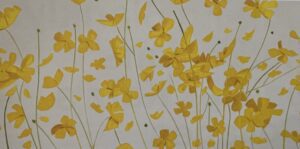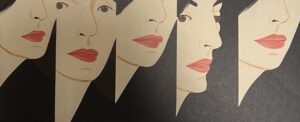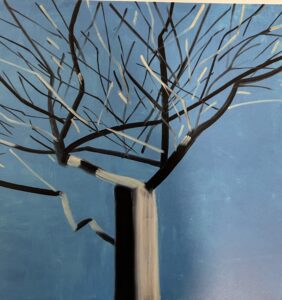Mark Bloch

The show, called “Gathering” takes its name from a 1951 poem by Alex Katz’s friend James Schuyler who wrote of gathering together beautiful flowers before they die and of gathering together one’s creative community.
The curator Katherine Brinson has used the unidirectional architecture of the Guggenheim Museum to convey a visual chronology of an artist who embraces community but wants no part of narrative, preferring isolated arresting images to any depiction of events that added up to a story. Despite the repetitive experience of looking into alcoves where large canvases are presented in groups of 2s and 3s, reminiscent of frames flickering by in film footage or the structure of a script, this artist also has no interest in seriality as a proxy for mass media imagery. He’s against it.
Yet, Alex Katz has often positioned the same figure in the same work multiple times, insisting they are not time-based revelations of the personality of the sitter but simply non-sequential images of gestures and expressions that co-exist simultaneously. His friend Edwin Denby, the American writer of dance criticism, poetry, a novel, and a frequent subject of Katz’s work, named them “splits.” Katz once referred to them as “non-psychological doubling,” but later admitted despite his best efforts, “it ended up being a psychological thriller.”
But is the thrill gone? Despite a positive experience being immersed in a narrative I was not supposed to have seen I did leave this exhibition wanting more. Recalling my passionate response to the 2021Alice Neel show at the Metropolitan Museum of Art in New York, I found myself wondering why the most interesting works in this show seemed to be little forays into post-modern experimentation that Katz had made over the years. Or a few surprising early drawings and collages. All my favorites were anomalies, not the body of work I came to see. This was an exhibition worth visiting but one that ultimately left me a bit numb and disappointed, with the march up Frank Lloyd Wright’s famous ramp feeling increasingly tedious.
Katz is so known for his familiar dramatically cropped faces over the past several decades that any consideration of portraits, be they by Lucien Freud, Chuck Close, Francesco Clemente, Jim Torok, Elizabeth Peyton, John Currin, Frida Kahlo or even Cindy Sherman, will eventually invite comparisons to Katz. His iconic effigies are now an art historical given, Katz’s trademarked evergreen contribution to the history of 20th and 21st century art and part of the scenery—with scenery Katz’s side hustle. Enormous landscapes that evolved since he studied plein air painting at the Skowhegan School of Painting and Sculpture in Maine in the late 1940’s are here in abundance and they conclude the exhibit in literally gargantuan abstract displays of color seen best from far away. Smaller oil on linen flowers are also present in the levels below and are resplendent. And let us not forget Katz’s master printmaking. Katz is no one trick pony. Of the 150-plus artworks in this exhibition, half are canvases including many portraits, but the other half are prints, drawings, collages, small oil studies and wood and aluminum figurative cutouts. All of it is worth seeing. But how can we re-imagine Katz as a more relevant contributor to life in 2023?
Despite oddities that undermine his stated intentions, Alex Katz is still going strong at age 95 so he deserves the retrospective and the ink. The young Katz, born in 1927, blossomed at a time when it was not fashionable to paint realistically, with the representation of the human figure considered particularly passé, making Katz’s most basic choices seem downright heroic. Yet, with the ability to recognize faces so important to our species that every human brain contains a region, the fusiform gyrus, solely devoted to that task, Katz’s brand as the master of the human close-up can also be considered, well, a no-brainer. Depicting faces was probably destined to come back into style at some point for an artist at work for 75 years. It did and he certainly helped.

But in addition to settling on a focus that may have seemed to some outmoded, Katz also chose to downplay the language of pop culture. Rather than paying homage, like many of his contemporaries, to a mediated world of pre-existing imagery and repetitive mechanical reproduction, Katz claimed to eschew glossy media uniformity, wanting to hunker down in the homespun world of the painterly. But in doing so he rejected the introspection and subjectivity of the disheveled Abstract Expressionist generation that preceded him. Katz didn’t want to capture who his subjects were or what they meant, just paint the way they looked.
It is ironic that Katz’s show at the Guggenheim stands in opposition to some of these very aims. Most importantly, Katz has become a pop star brand unto himself, establishing his name and the look of his art as a predictable media image while his pledged devotion to the painterly has left a slick and icy trail, as far as possible from the rumpled and untidy world of Pollock and Rothko. If any connection remains, it would be a thin thread to the early figures of de Kooning—and a connection to it via a dispassionate flatness reminiscent of Color Field Painting.
While attempting to hold media in relation to his art at arms-length, he acknowledges that his paintings are destined to be seen by the same eyes as those that have been trained to absorb movies, fashion magazines and, most of all, billboards. Again, this show is by no means all portraits. In addition to flowers, there are large numbers of landscapes inspired by “initial blasts of light” in the “here and now,” and “visual experiences in the present tense,” which he sketches in painted studies, then recreates larger and more controlled. Nevertheless, both the size and the original optically inspired glimpses of eternity that catch his eye in moments of what he calls “absolute awareness” might explain Katz’s more than occasional references to billboards.
Despite these contradictions, what moved me? When I say Post-modern I am referring to two fragments of faces awkwardly cut off, floating on a sea of bold yellow in “Bill Free” (2017), a double portrait of Bill T. Jones, the conceptual dance innovator since the 1970s, interesting to me because it suggests what Katz was capable of had he used his “brand” as a weapon of self- parody. I found its clumsiness refreshing.
A couple of earlier works struck me too. They preceded the ‘60s through the ‘80s run when Katz may have peaked. Two spirited, painterly pieces made me wonder what might have happened had he not morphed into depicting the circle of painters, poets, and dancers with whom he was closest in his flat, blemish-free way. “Irving and Lucy” (1958) showed art historian Irving Sandler and his wife Lucy Freeman surrounded by a large white creamy background that matched Sandler’s blazer. And a double image of Katz’s wife in a blue robe with arms crossed, “Ada Ada” (1959) was also brushy and surrounded by plenty of space. I wondered in what alternative universe this softer, more expansive style by Katz might have continued.
Granted, Katz’s portraits of his wife since 1959, Ada Del Moro, once a scientific researcher, are magnificent. Another irony is that not only did Katz turn his own name and art into pop icons, but this show makes it clear he also managed to turn his muse Ada into the stuff consumer archetypes are made of. Unfortunately, her psychology is impenetrable. Katz’s aversion to such things reveals nothing about a 65 year rom-com. Six older Ada’s fading out as they walk away from the viewer with her feet hidden by the green grass of a field bespeckled by light coming through unseen trees made a nice counterbalance to six other Ada’s earlier in the show: seated, standing, arms crossed, hand on hip in “The Black Dress” (1960). Once more with no feeling.
Finally, I was struck by “Ada’s Back” (2021) consisting only of hair uncharacteristically not cut off at the top, but just brush strokes that taper into a white background. The fact that this constitutes a daring departure in Katz’s world (not to mention that it was hung among the final 5 landscapes in the show) speaks volumes. But speak it did because it was different.
Finally, I cannot speak more favorably about Katz’s “cut outs.” He created his first one of Frank O’Hara on a wood panel in 1959-60, seen here, and has continued the rest of his life. They are exciting because they break convention, between the worlds of painting and sculpture and often fun images of his familiar friends. “Edwin and Rudy” of Denby and Burckhardt is a standout.

Fun is the magic word here. There should be more. Rather than attempting to convince myself to care about Katz’s strong detached convictions about art that don’t seem to add up anyway, I would like to know more about the ardour of his subjects and how he feels about it. Regretfully, it just is not here. Katz could not be more competent. He is a benchmark for images of cropped faces in that critical era just before post-modernism crept in via Duchamp and Cage in the 1960s, making him a pinnacle of Modernism. But we must ask ourselves—should it continue and if so, why?
In a well-known work, “Cocktail Party” (1965), Denby, Al Held, Joe Fiore, Burckhardt and others gathered at the Katzs’ home near Madison Square Park for a party. We know by now, every summer Katz and presumably Ada and their kids went from there or a SoHo loft to a 19th-century clapboard farmhouse about halfway up the coast of Maine. In both spots, Katz has spent his time painting the circle of painters, poets and dancers with whom he has been closest: Denby, Ted Berrigan, who is seen here in a 1967 crudely swabbed-on oil sketch that hangs next to a more idealized “finished” replica, LeRoi Jones in ’63 before he became Amiri Baraka, Kynaston McShine of MoMA and then Allen Ginsberg in a six-panel chopped up portrait that did not look much like him. Did that lack of resemblance play a part in Katz chopping things up in the first place? Then a cut-out of Francesco Clemente that looked exactly like him. Performance artist Joan Jonas was pictured in a recent portrait. Katz was the official chronicler of the postwar New York School of Painters and Poets and, yes it was exciting to see each work, of the famous and the not-so-famous, done in Katz’s inimitable style.
But like the people in the 1965 cocktail party painting, something barely detectable was missing. When we look closely we see the attendees are not looking at each other. Like ships passing in the night, Katz’s party was in danger of collapsing under the weight of its own detachment.
His journey had begun with a small portrait of the artist’s mother with a slight twinkle in her eye and progressed toward a dramatic final series of sparse almost abstract landscapes on the top floor of the Guggenheim that looked to be a city block long, enormous examples of Katz’s acumen and successful career. Katz had moved from tiny ink sketches in the subway to pastel colors collaged onto a surface to find his way and later to bolder colors and shapes that earned him more popularity while sacrificing some of his own passion and the passion of this community. The twinkle was gone.
